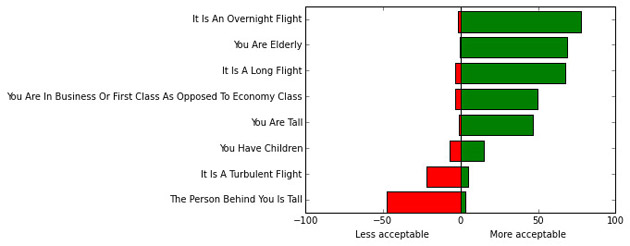
To this end, I designed a survey to study people’s views on leaning seats back. Huge thanks to the people who shared it on Facebook and Twitter1. We collected 216 full survey responses, and from analysis of those responses, I drew four lessons which will hopefully keep you flying the friendlier skies.
Lesson 1: Know what is socially acceptable.
Here are five things you might do in economy class on a plane ranked in descending order of how okay they are.
| 'Agreed' or 'Strongly Agreed' that this is acceptable | 'Disagreed' or 'Strongly Disagreed' that this is acceptable | |
| Leaning your seat back | 73% | 16% |
| Saying no if the person in front of you asks if they can lean their seat back | 47% | 31% |
| Asking the person in front of you not to lean their seat back | 44% | 40% |
| If you ask if you can lean the seat back, and the person says no, doing it anyway | 19% | 66% |
| Purchasing a device, like a Knee Defender, to prevent the person in front of you from leaning back | 12% | 79% |
People are clearly decided on three of the actions: it’s okay to lean your seat back, but it’s very not okay to ignore the person’s request that you don’t, and it’s even less okay to purchase a Knee Defender. People are split, however, on whether it’s okay to say no yourself – whether by asking the person unsolicited, or even by saying 'no' if they ask your permission.
Confession: I ran this survey expecting to find that tall people were less okay with leaning seats back. This is because my boyfriend and my dad, two mild and lovely people who are 6’ 0” and 6’ 3” respectively, rarely express annoyance at anything – the exception being people who lean their seats back. If even these gentle giants get irritated, I reasoned, surely we have to fear the less even-tempered ones.
But! In my data, there is no statistically significant correlation between height and how acceptable a person thinks it is to lean a seat back, or with any of the other acceptability questions, regardless of whether I control for other factors2. The males in my life have misled me, but statistics have opened my eyes. The moral, I guess, is to not become emotionally close to anyone because that will bias you as a statistician. You will be pleased to know that, in my quest for statistical purity, I have now severed all ties with my boyfriend and father3.
Granted, it’s not a huge sample. But an effect that doesn’t emerge in a sample of 200 people is maybe not an effect you want to risk getting into a fist fight over. (The 95% confidence interval for my height coefficient is [-0.045, -0.046], which means that my model estimates that adding a foot to someone’s height moves them at most halfway from 'Agree' to 'Strongly Agree'. That’s just not a very big effect.) Which brings me to…
Lesson 2: Do not make assumptions based on the person behind you.
It wasn’t just height that didn’t predict how someone would feel about leaning seats back: it was also their gender, age, American citizenship, whether they enjoyed flying, how comfortable they found airline seats, how often they flew economy, and how often they flew first or business. So, my children, do not judge the person behind you by such superficial features. Instead, take the time to stare deeply into their soul, or else retweet this survey so we can get enough data to stereotype in a statistically significant way.
On the one hand, it’s kind of cool that we can identify something that people feel passionately and unpredictably about. On the other hand, not being able to predict things sucks. But there is a bright side from the prediction standpoint.
Lesson 3: It’s often safe to make assumptions based on the situation.
I asked people whether various situational nuances increased or decreased the acceptability of leaning one’s seat back. Here are the nuances – green denotes the fraction of people saying it made it more acceptable to lean your seat back, and red, less acceptable.

So, while you shouldn’t make assumptions based on the person, you can sometimes make assumptions based on the situation. Translation: anyone who keeps you from leaning your seat back on a redeye is by social consensus a horrible person and deserves to be pelted with pretzels.
Here again, the characteristics of the person fail to predict their views. For example, tall people respond no differently to the questions about being tall, and women respond no differently to the question about children.
The thing is, you could follow the first three rules and still get punched, because…
Lesson 4: Some people are just weird.
Sorry, I really appreciate everyone filling out this survey and I don’t mean to hate. But there are certain answer combinations that don’t really make sense to me. For example, if I say that it’s acceptable to buy a Knee Defender, I should also think it’s acceptable to ask someone not to lean their seat back, or to say no if they ask if they can – both are way less provocative. And yet there are people who say it’s okay to buy the Knee Defender but not to just talk to the person – to these people I would recommend a less passive-aggressive form of conflict resolution.
I’m also confused by the people who say it’s okay to lean your seat back but also say it’s acceptable to use a Knee Defender – these things cannot occur simultaneously, guys. Also, watch out for the people who think it’s okay both to use the Knee Defender and to ignore the person who asks them not to lean back – these people are the Nietzsches of economy class, and will rely on brute force both to get into your lap and keep you out of theirs.
All of these groups were quite small, but the lesson is: there are outliers in every sample, and one of them might be sitting right behind you. Also, if people do weird things when sitting comfortably at their computers, they probably do even weirder things when they’ve been squeezed into a tiny coffin for four hours breathing deoxygenated and virus-laden air. God, I hate flying.
Two important caveats here. First, this is a weird sample – my Facebook friends, and the friends of my Facebook friends – which does not represent the whole population. One obvious difference is that 84% of the respondents were between 18 and 25. So if there is, for example, a crotchety old person demographic or an angry baby demographic, they will not be captured here. (There is also, incidentally, a suspiciously small number of men in the survey reporting that they are 5’ 11” – probably they’re rounding up to 6 feet.)
Second, asking people what they find 'acceptable' leaves room for a lot of interpretation – does that mean acceptable for me to do, or acceptable in general? If I say something is unacceptable, does that mean I’ll disembowel you if you do it, or just that I find it slightly rude? Please bear these caveats in mind, be civil, treat this as a fun experiment as opposed to a scientifically rigorous paper, and don’t write me angry emails if you get assaulted with a tray table. But on the other hand, if the person behind you insists on buying a Knee Defender, feel free to cite this survey as evidence that society condemns them to hell.
This article first appeared on Emma's Obsession with Regression blog.
Footnotes
- 1. Thanks to Maria Mateen, Danielle Rossoni, Sarah Weston, David Ryan, Nat Roth and Scott McWilliams, among others, as well as all their friends who then reposted the survey – this would never have worked without you. (I should probably have mentioned this earlier, but it’s really tremendously helpful and gratifying when people repost content – thanks if you have.)
- 2. All factors examined: your gender, your age, whether you enjoy flying, how comfortable you find airline seats, whether you’re an American citizen, how often you fly economy, and how often you fly first or business.
- 3. This is, obviously, a joke, but there is a serious lesson here – we learn about how people work from a very small and biased sample, and while personal experience is evocative and compelling, it’s an unreliable way to draw general conclusions.



